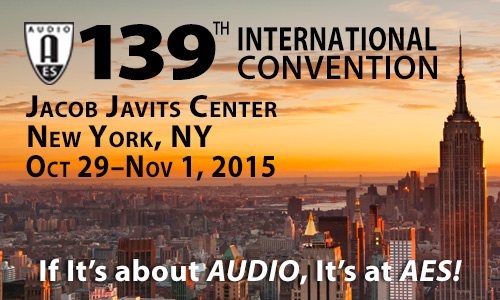
AES New York 2015
Paper Session P2
P2 - Audio Education
Thursday, October 29, 9:00 am — 12:00 pm (Room 1A07)
Chair:
Tim Ryan, Webster University - St. Louis, MO, USA
P2-1 LabVIEW as a Music Synthesizer Laboratory Learning Environment—Edward B. Stokes, University of North Carolina at Charlotte - Charlotte, NC, USA; Ed Doering, Rose-Hulman Institute of Technology - Terre Haute, IN, USA
Most electrical engineering (EE) students are familiar with LabVIEW. This graphical programming environment is commonly used in university EE educational and research labs to facilitate data acquisition and processing using a suite of built-in mathematical, DSP, and communication functions. LabVIEW is particularly adept at emulating control panels with a variety of knobs, sliders, and gages. The audio functionality of LabVIEW, along with its “knobby” user interface, makes it ideal for exploration of music synthesis concepts by EE students. In this paper several types of music synthesis are explored in LabVIEW. Implementation of these in elective EE coursework gives EE students a unique opportunity to experience abstract concepts such as waveforms, frequency, filtering, and envelopes through their auditory cortex, reinforcing what they have learned through traditional pedagogy, and also provides EE students an introduction to some basic audio engineering (AE) concepts.
Convention Paper 9361 (Purchase now)
P2-2 A Model for International and Industry-Engaged Collaboration and Learning—Mark Thorley, Coventry University - Coventry, Warwickshire, UK
Traditional barriers of geography, organization, and culture and being broken down by emerging technology [1]. In the recording industry, professionals often collaborate on projects globally, engaging in what Tapscott and Williams [2] call “peer-production.” The potential in these concepts extends to those developing their expertise—they can connect with peers and industry professionals on a global scale. Despite the potential however, most Higher Education institutions fail to engage for cultural reasons. This paper outlines a model for collaborative learning explored and developed through a project funded by the UK's Higher Education Academy. The project involved Coventry University and industry organization JAMES as well as a number of other international partners. The paper looks at the pedagogical background to the project, some typical activities undertaken before summarizing the key outcomes and opportunities for further work.
Convention Paper 9362 (Purchase now)
P2-3 From Creativity to Science and Back Again: Supporting Audio Students Through Active Teaching Approaches—Jason Fick, The Art Institute of Dallas - Dallas, TX, USA
Many students enrolling in audio programs are not fully aware of the importance of science for the audio professional. Typically these students are creative but may have deficiencies in math and science. My goal as an instructor is to minimize the negative associations of these subjects through active lesson plans that stress practical audio situations in a compelling and interactive manner. As a result, students develop confidence through their ability to use science as a tool to both solve audio problems and create expressive art forms. My approaches empower them to succeed in early courses, which facilitate creative applications in later classes. Consequently, students are better prepared for the job force using skills that promote both technical and creative capacities.
Convention Paper 9363 (Purchase now)
P2-4 The Use of Digital Reverberation Projects to Teach Audio Signal Processing—Benjamin D. McPheron, Roger Williams University - Bristol, RI, USA; Kelsey M. Cintorino, Roger Williams University - Bristol, RI, USA; Nicholas J. Benoit, Roger Williams University - Bristol, RI, USA; Abdulrahim S. Hasan, Roger Williams University - Bristol, RI, USA; Kevin J. Oliveira, Roger Williams University - Bristol, RI, USA; Andrew D. Senerchia, Roger Williams University - Bristol, RI, USA; Daniel M. Wisniewski, Roger Williams University - Bristol, RI, USA
Hands-on application is essential to the development of practicing engineers capable of designing and implementing digital signal processing methods. The application of digital signal processing to audio applications provides students with instantly gratifying results and further develops future audio engineering professionals. In order to provide deeper understanding of audio processing techniques, students can be presented with projects that challenge them to create unique applications or methods in the field of audio processing. This work reports the project framework and outstanding student work resulting from implementing this method in a digital signal processing course, as well as the assessment strategy used to evaluate student understanding of key audio engineering techniques.
Convention Paper 9364 (Purchase now)
P2-5 Audio Recording and Production Education: Skills New Hires Have and Where They Reported Learning Them—Doug Bielmeier, Purdue School Of Engineering, IUPUI - Indianapolis, IN, USA
To understand how audio recording and production programs meet the needs of the larger entertainment industry, this study directly asked new hires what skills they have and where they were learned. In the New Hires Survey they were asked to rate the level of proficiency of their skills, where they learned these skills, and what skills they need to learn. The new hires reported learning basic technical skills during formal audio recording and production training but learned social and communication skills on their own or on the job. They requested a greater emphasis on career-critical areas of live sound and music business. Further research is recommended to understand industry needs, identify best practices for the acquisition of skills, and to determine how educational institutions can keep pace with the ever-changing entertainment industry.
Convention Paper 9365 (Purchase now)
P2-6 Case Study: Expanding Audio Production Facilities at Ohio University to Accommodate Student Needs—Kyle P. Snyder, Ohio University, School of Media Arts & Studies - Athens, OH, USA
Creating a recording facility is equal parts art and science. However, designing and adapting recording studios in higher education environments presents several challenges unseen within the commercial arena. In its third major design iteration since the formation of the College of Communication in 1968, the School of Media Arts & Studies has expanded its facilities to include a new mixing and mastering suite, an expansive 5.1 post-production and critical listening facility, and numerous classrooms and additional lab spaces, more than tripling the space available to faculty, graduate, and undergraduate students.
Convention Paper 9366 (Purchase now)
